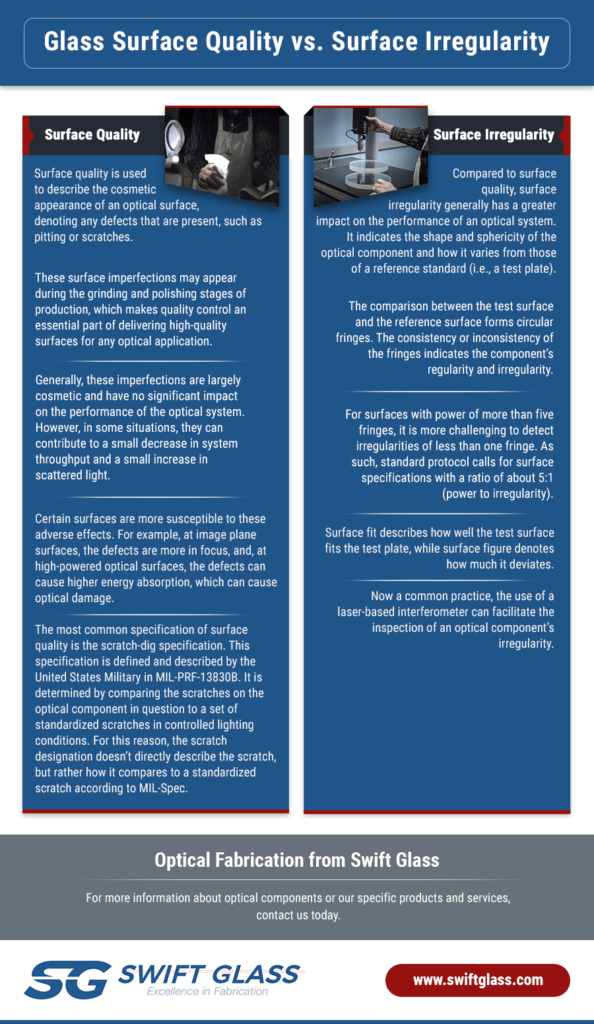During the design and production of optical devices and systems, optical specifications—such as surface quality and surface irregularity—serve two key purposes:
- To set the acceptable limits for various performance parameters
- To determine the amount of resources required for production
While an optical component may appear to be perfect—i.e., without defect—to the human eye, there may still be minuscule surface quality issues and irregularities that affect the performance of the optical device when the component is used. In optics, operations often occur on scales measured in nanometers or billionths of a meter. As such, even the slightest variation in a component can cause significant distortion or degradation of optical quality.
Understanding how the surface of an optical component may vary and how those variations affect performance are crucial to determining which parts are right for a given application. The following blog post provides an overview of two commonly utilized optical specifications—surface quality and surface irregularity.
Overview of Surface Quality
Surface quality is used to describe the cosmetic appearance of an optical surface, denoting any defects that are present, such as pitting or scratches. These surface imperfections may appear during the grinding and polishing stages of production, which makes quality control an essential part of delivering high-quality surfaces for any optical application.
Generally, these imperfections are largely cosmetic and have no significant impact on the performance of the optical system. However, in some situations, they can contribute to a small decrease in system throughput and a small increase in scattered light. Certain surfaces are more susceptible to these adverse effects. For example, at image plane surfaces, the defects are more in focus, and, at high-powered optical surfaces, the defects can cause higher energy absorption, which can cause optical damage.
The most common specification of surface quality is the scratch-dig specification. This specification is defined and described by the United States Military in MIL-PRF-13830B. It is determined by comparing the scratches on the optical component in question to a set of standardized scratches in controlled lighting conditions. For this reason, the scratch designation doesn’t directly describe the scratch, but rather how it compares to a standardized scratch according to MIL-Spec. For more info, see this Scratch-Dig Specification Guide.
Overview of Surface Irregularity
Compared to surface quality, surface irregularity generally has a greater impact on the performance of an optical system. It indicates the shape and sphericity of the optical component and how it varies from those of a reference standard (i.e., a test plate).
The comparison between the test surface and the reference surface forms circular fringes. The consistency or inconsistency of the fringes indicates the component’s regularity and irregularity. For surfaces with power of more than five fringes, it is more challenging to detect irregularities of less than one fringe. As such, standard protocol calls for surface specifications with a ratio of about 5:1 (power to irregularity). Surface fit describes how well the test surface fits the test plate, while surface figure denotes how much it deviates.
Now a common practice, the use of a laser-based interferometer can facilitate the inspection of an optical component’s irregularity.
Optical Fabrication from Swift Glass
Optical components are found in many devices and systems, ranging from consumer cameras to machine vision imaging devices to biometric iris identification systems. Which components are employed depend on the application. The type, specifications, and tolerances need to meet the performance requirements as well as justify the investment cost.
At Swift Glass, we are fully committed to fabricating the highest quality optical components in the market. Before delivery, we subject each piece—whether in prototype or full-production runs—to several levels of quality control. These inspection processes, including first-piece inspection, random sampling, and final inspection, ensure all of our products meet customer requirements and our quality standards.
For more information about optical components or our specific products and services, contact us today. Additionally, check out our new interactive conversion tool designed to calculate measurement conversions from micron to fringe to wave.






